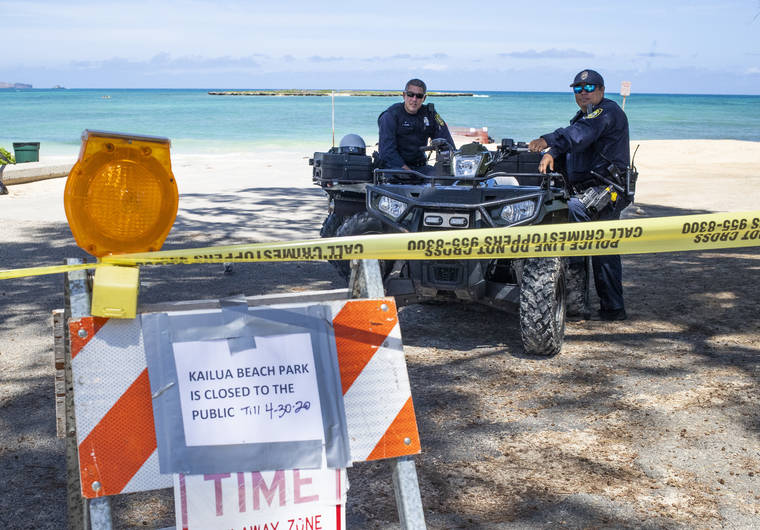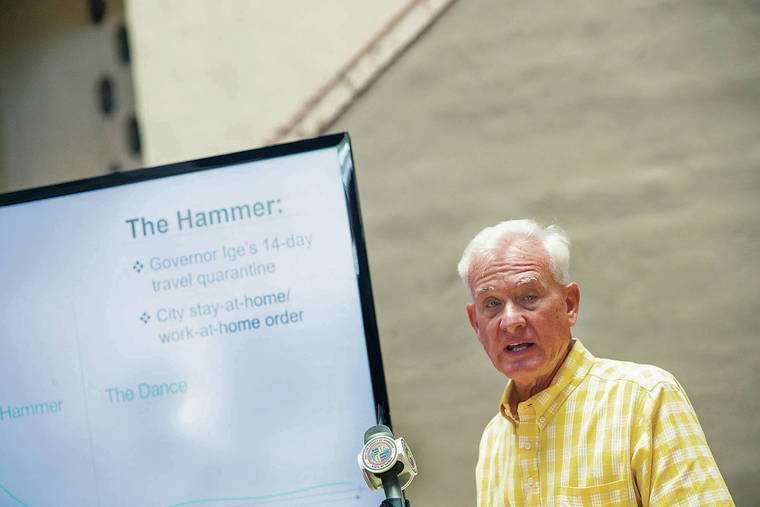Emergency stay-in-place orders issued for Honolulu and Maui

CINDY ELLEN RUSSELL / CRUSSELL@STARADVERTISER.COM
Honolulu police officers were on watch Saturday at the entrance of Kailua Beach Park. “It’s like trying to stay dry while standing in the rain,” said one of the officers on keeping the beachgoers away from closed parks due to the COVID-19 pandemic.

CINDY ELLEN RUSSELL / CRUSSELL@STARADVERTISER.COM
“I don’t think we should build up expectations that it’s going to be quick.”
Kirk Caldwell
Honolulu mayor


Honolulu Mayor Kirk Caldwell issued an emergency order Sunday requiring everyone except essential workers to shelter in place from Monday at 4:30 p.m. through at least April 30 in a move to fight the spread of the coronavirus Opens in a new tab.
Shortly after Caldwell’s Opens in a new tabannouncement Opens in a new tab, Maui County Mayor Mike Victorino issued a similar “stay at home and work at home” order Opens in a new tab for his four-island county. Kauai Mayor Derek Kawakami indicated he will do the same today.
Gov. David Ige issued a statement supporting the orders and suggested a similar plan is in the works for the entire state.
“We have been working together on this issue, and this morning we agreed that the mayors should develop their own plans to meet the unique needs of their counties. We also agreed that statewide action will be needed. I have directed the Attorney General to review the orders other states have issued and prepare a statewide plan that will keep the people of Hawaii safe and healthy,” the governor said.
House Speaker Scott Saiki urged Ige to establish a statewide stay-in-place order, because otherwise the uneven regulations would create widespread confusion.
Don't miss out on what's happening!
Stay in touch with breaking news, as it happens, conveniently in your email inbox. It's FREE!
Earlier in the day, the state Department of Health reported that eight more people — including another child — tested positive for the new coronavirus in Hawaii, bringing the statewide tally to 56, including 41 on Oahu.
Caldwell’s emergency order comes one day after Ige ordered visitors and residents returning to the islands to undergo a 14-day quarantine starting Thursday.
Honolulu and Maui become the latest in a growing list of American municipalities and states issuing orders to stay home, including New York, San Francisco, New Orleans, Philadelphia St. Louis and Kansas City, Mo.
At a news conference Sunday afternoon at Honolulu Hale, Caldwell said Hawaii faces a worst-case scenario of 40,000 to 45,000 cases by the end of April if drastic action isn’t taken.
The mayor said Hawaii has fewer than 300 intensive care units in the state, and projections based on a statistical analysis indicate that Hawaii could exceed its capacity of ICU beds by April 25.
Caldwell said countries that imposed strong actions against the coronavirus have been able to lessen the demand on their health care systems and avoid situations such as in Italy where health care professionals have been forced to make decisions about who lives and who dies.
“We don’t want to face any of these scenarios,” he said. “So we’re taking this action to buy time.”
Caldwell described the stay-at-home order, in combination with the 14-day quarantine, as “The hammer,” designed to bring the number of cases down and flatten the curve. If it works, he said, Hawaii could see its infection rate come down in about three to seven weeks, leading to a period described as “The Dance,” when the infection rate is suppressed but the virus doesn’t go away.
“One thing we need right now is time, and these measures are going to buy us time,” Honolulu Department of Emergency Management Director Hiro Toiya said.
Time, Toiyo said, will help alleviate a growing concern that the state’s health care system is running out of personal protective equipment for health care workers, along with other essential supplies needed to combat the virus, such as ventilators.
The measures will not only allow the island’s health care system time to obtain the supplies and equipment it needs to treat patients, he said, but they will allow for the acquisition of rapid testing for COVID-19 and the development of more effective treatments.
“If we can buy some time, we can allow the manufacture and distribution of these supplies to ramp up so we can have sufficient supplies to care for everybody,” Toiyo said.
While the order ends April 30, Caldwell said it will likely be extended. For how long, he didn’t know.
“I’m hopeful,” the mayor said when asked how long the order will last. “I just can’t answer your question as to how long it’s going to be. And I don’t think we should build up any expectations that it’s going to be quick.”
It’s unclear how many of Oahu’s nearly 1 million residents would be affected by the order, since Caldwell unveiled a long list of essential businesses exempt from the order.
Among the businesses in 26 categories exempt from the order are grocery stores, farms, banks, hardware stores, plumbers, education institutions, laundromats, transportation workers, home-based care for seniors, professional services, funeral homes, private detectives and the media.
Under the order, residents are permitted to step out for essential activities such as obtaining medical supplies or medication, visiting a health care professional, obtaining necessary services or supplies such as groceries, and outdoor activities in locations as permitted by law.
Travel will be limited to essential activities or to operation of essential business or essential government functions.
Violation of the order is punishable as a misdemeanor, with fines of up to $5,000, up to a year in jail or both.
“At the end of the day, this is about protecting our ohana,” Caldwell said. “It’s not a perfect order, maybe — and if there are issues raised that need to be adjusted, we can amend the order.”
On Maui, Mayor Michael Victorino’s “stay at home and work from home” order is similar to Caldwell’s, only the start is at 12:01 a.m. Wednesday.
“Decisive action is needed to stem the spread of COVID-19 and protect our healthcare resources, our hospital beds, respirators and the health and safety of doctors, nurses and other healthcare professionals,” Victorino said in a news release. “I humbly ask all of us to do our part to flatten the curve and come together as a community.”
Honolulu Mayor Kirk Caldwel… by Honolulu Star-Advertiser on Scribd
Maui Stay at Home Amendment by Honolulu Star-Advertiser on Scribd



